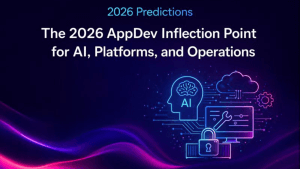At Nutanix .NEXT 2025, the company signaled a strategic pivot toward becoming a full-stack platform for hybrid multicloud operations, AI readiness, and application modernization. Building on its hyperconverged infrastructure (HCI) foundation, Nutanix now aims to serve as a unified control plane for enterprise IT, enabling organizations to run traditional and cloud-native applications seamlessly across private data centers, public clouds, and edge environments. This approach is underscored by focusing on cloud and infrastructure lifecycle management, now widely recognized as a top enterprise priority. By 2026, 80% of enterprise workloads will be deployed in environments requiring unified lifecycle management across on-prem and cloud infrastructure. Nutanix’s platform—anchored by Nutanix Cloud Infrastructure (NCI) and Nutanix Cloud Clusters (NC2)—responds to this need with consistent policy-driven provisioning, operations, scaling, and governance across heterogeneous environments.
The transition of VMware workloads represents a significant short-term and strategic opportunity for Nutanix. With Broadcom’s restructured VMware offerings and licensing changes disrupting the industry, including research reports that over 30% of current VMware customers are evaluating exit strategies. Nutanix is capitalizing on this shift by offering a stable, performant alternative that supports vSphere VMs alongside modern workloads. The ability to manage both VMs and Kubernetes clusters via Nutanix Prism and Nutanix Kubernetes Platform (NKP) provides a single pane of glass for application owners and infrastructure operators alike. This dual-mode capability is critical for platform teams under pressure to support legacy applications while accelerating container adoption.
Taking Aim at VMware, Red Hat in the Battle for Cloud-Native Dominance
However, Nutanix is not alone in this race. Competitors like Red Hat OpenShift provide mature Kubernetes-based platforms with deep integrations into CI/CD toolchains, while Portworx (Pure Storage) offers advanced storage automation for containers. VMware’s VCF still retains market share, particularly in regulated industries, and hyperscalers like AWS, Azure, and Google Cloud offer hybrid extensions and proprietary lifecycle tooling that tie customers deeper into their ecosystems. Nutanix differentiates itself by providing cloud-neutral lifecycle management that preserves flexibility and avoids lock-in, an attribute that Forrester found 74% of enterprise IT leaders now consider essential when selecting modern infrastructure platforms.
Beyond infrastructure modernization, Nutanix has made AI and ML workloads a central growth pillar, aiming to simplify enterprise adoption of large language models (LLMs), agentic AI, and inference pipelines. Despite aggressive vendor marketing, real-world enterprise AI adoption remains in early stages. McKinsey’s 2024 global AI survey found that 55% of companies had experimented with generative AI, and only 12% had operationalized it at scale. One reason for this is the infrastructure gap: many AI workloads demand GPU-accelerated environments, low-latency data access, and fine-grained governance—all of which traditional enterprise platforms are ill-equipped to deliver.
Nutanix addresses this by expanding its Nutanix Enterprise AI (NAI) platform, integrating NVIDIA NeMo, curated AI models, and guardrails for ethical AI operations. The stack includes lifecycle management of AI pipelines, from sandboxing to production, via simplified infrastructure-as-code templates and GPU-as-a-service capabilities. Notably, Nutanix supports hybrid deployment models where sensitive data and models can remain on-premises while leveraging cloud-like scalability. This hybrid AI approach aligns with the growing preference for “AI factories”—dedicated environments for training, fine-tuning, and serving models. Industry data projects that by 2026, 30% of enterprises will deploy such AI model factories, driven by regulatory concerns and the need for IP protection. Nutanix is positioning itself as the infrastructure provider for this emerging category, offering GPU orchestration, model isolation, and secure pipelines—all wrapped in a turnkey package.
A key pain point in AI adoption is overprovisioned and underutilized infrastructure. Enterprises often allocate large idle GPU clusters due to poor pipeline orchestration or misaligned scaling. Nutanix mitigates this with dynamic workload placement, intelligent scheduling, and support for Kubernetes-native GPU sharing—features increasingly in demand as organizations strive to maximize return on expensive AI hardware. If Nutanix can match the provisioning simplicity of hyperscalers while delivering cost-effective, hybrid AI operations, it could gain significant traction in AI-heavy verticals like healthcare, financial services, and manufacturing.
Parallel to AI, security and data protection remain foundational concerns. As DevOps and AIOps accelerate, enterprises struggle to reconcile agility with risk mitigation. Traditional security approaches often create bottlenecks, forcing trade-offs between innovation speed and compliance. Nutanix seeks to dissolve this tension by embedding zero-trust architectures, encryption at rest and in transit, and role-based access controls directly into its infrastructure and orchestration layers.
Through integrations with Citrix, Omnissa (formerly VMware EUC), and leading security platforms, Nutanix delivers virtual desktop infrastructure (VDI) and application streaming environments hardened for regulated sectors. Additionally, its native support for immutable backups, snapshot-based recovery, and ransomware detection addresses the surge in cyberattacks targeting hybrid environments. A recent report by IBM Security revealed that the average data breach cost in hybrid cloud environments reached $4.75 million in 2023—14% higher than cloud-only or on-prem-only environments, underscoring the need for tightly integrated, cross-environment protection mechanisms.
From a broader market perspective, Nutanix’s approach aligns with a growing enterprise appetite for platform consolidation and operational simplification. According to research, 69% of enterprises are actively looking to reduce the number of infrastructure management tools they use, driven by tool sprawl, talent shortages, and integration complexity. Nutanix’s integrated platform—spanning VMs, containers, data services, AI, and security—positions the company to answer this need with a unified control fabric. The recently released Nutanix Kubernetes Platform (NKP) 2.14 exemplifies this direction, featuring support for Kubernetes 1.31, Traefik v3.x ingress, a Harbor-based container registry, and seamless integration with Nutanix Objects for stateful applications. This version also supports air-gapped environments, catering to sensitive sectors like defense and healthcare.
In sum, Nutanix is not merely chasing cloud transformation—it’s reshaping itself to become the digital platform underpinning modern enterprise operations. Its strategic trifecta of lifecycle management, AI enablement, and embedded security offers a compelling value proposition for CIOs, CDOs, and infrastructure leaders navigating digital transformation. With a TAM expected to surpass $120 billion across HCI, hybrid cloud, and AI infrastructure by 2030, Nutanix has the technological foundation and market alignment to expand its relevance in the coming years.
Paul’s Take
At Nutanix .NEXT 2025, the company positioned itself as more than a hyperconverged infrastructure (HCI) vendor—it’s now making a concerted push to become a full-spectrum platform for hybrid multicloud, cloud-native, and AI-ready enterprise environments. With its theme, “Run Anything Anywhere,” Nutanix has a future defined by workload portability, cloud-neutral infrastructure, and integrated lifecycle management—three pillars increasingly central to enterprise IT strategies in 2025 and beyond.
Nutanix’s announcements address three distinct, but converging enterprise imperatives: modernizing IT infrastructure without disruption, securely scaling AI workloads, and consolidating management of virtual machines and containers through a unified, policy-driven control plane. This trifecta aligns with current market dynamics. CIOs face rising pressure to reduce cloud costs, respond to AI initiatives, and navigate a post-VMware environment amid Broadcom’s ongoing transformation of VMware’s partner ecosystem.
- Cloud and Infrastructure Lifecycle Management Will Be the New Battlefield
- Nutanix is entering a crucial race to onboard displaced VMware workloads, aiming to offer a soft landing for customers wary of licensing uncertainty and support fragmentation. The company’s integration-centric approach—supporting Dell PowerFlex, Pure Storage, Cisco UCS, and others—provides flexibility and minimizes switching costs, an essential value proposition as 64% of enterprises prioritize modernizing existing IT stacks over complete replacement.
By supporting both VMs and containers side-by-side via Prism and Nutanix Kubernetes Platform (NKP), Nutanix is directly competing with platform providers such as Red Hat OpenShift, SUSE Rancher, and Canonical, while also challenging cloud-native hyperscalers. The real differentiator lies in policy-driven lifecycle management, which research ranks as a top priority for enterprise IT by 2026. This will be critical as organizations demand greater automation, consistency, and governance across heterogeneous environments.
Expect Nutanix to double down on automation, platform abstraction, and ecosystem expansion. This will likely involve deeper AIOps integration and declarative infrastructure as code (IaC) capabilities to simplify Day 2+ operations.
- AI & ML Workloads Are a Strategic Growth Vector—but Practicality Will Win
- While much of the AI infrastructure discussion 2024 has centered on GPU availability and LLM benchmarks, Nutanix is instead betting on simplified AI onboarding as its go-to-market wedge. By integrating with NVIDIA NeMo and embedding lifecycle, inference, and guardrail tooling into the Nutanix Enterprise AI platform, the company provides a turnkey experience that resonates with mid-market and regulated enterprises, those reluctant to send proprietary data to public clouds.
Critically, the rise of “AI factories”—dedicated environments for model development, fine-tuning, and deployment—is beginning to shift AI infrastructure decisions away from ad hoc experimentation toward long-term architectural planning. Research estimates that by 2026, 30% of enterprises will operate internal AI model factories, while 55% will prioritize hybrid AI infrastructure to balance performance and control.
Nutanix is well-positioned to capture enterprise demand for private AI environments that support real-world use cases (e.g., document summarization, customer service augmentation, regulatory compliance). Expect partnerships with GPU vendors, ISVs, and data pipeline providers to grow, along with reference architectures for industry-specific deployments.
- Security and Data Protection Must Scale with Platform Usability
- Security and compliance remain non-negotiable for enterprise IT, and Nutanix’s expanded integration with Citrix, Omnissa (VMware EUC), and built-in guardrails signal a growing focus on secure-by-default design. This is particularly timely as enterprises seek to eliminate the long-standing trade-off between speed and security.
For Nutanix to differentiate, it must deliver the right security features—RBAC, encryption, immutability, and behavioral analytics—and simplify how platform engineers and developers consume them. As cloud-native threats increase and compliance frameworks tighten (especially in regulated sectors), Nutanix’s ability to embed security within its lifecycle management fabric will be a key advantage.
Future innovation should include broader support for CSPM (cloud security posture management), automated compliance reporting, and integration with third-party SecOps tooling (e.g., Splunk, Sentinel, CrowdStrike).
It is also important to mention Project Beacon. It is Nutanix’s forward-looking initiative aimed at decoupling applications and data from the underlying infrastructure, enabling true portability across hybrid multicloud environments. With Project Beacon, Nutanix is evolving its platform to deliver cloud-native data services, such as databases, key-value stores, and streaming services, as fully managed offerings that can run on any Kubernetes environment, whether on-premises, in public clouds like AWS, Azure, or GCP, or at the edge. This vision reflects a broader industry trend: according to IDC, over 80% of enterprise applications are expected to be cloud-native or modernized by 2027, and the ability to abstract data services away from infrastructure is increasingly seen as critical to enabling DevOps agility, cost optimization, and vendor independence. Project Beacon allows developers to consume these services via APIs while IT maintains centralized control, bridging the often-fragmented relationship between platform teams and software engineers.
Technically, Project Beacon leverages Nutanix Data Services for Kubernetes (NDK), which builds on the company’s HCI foundation, to deliver persistent, scalable, and resilient storage to containerized workloads. As enterprises struggle with data gravity and lock-in, Project Beacon provides a compelling alternative by offering a consistent control plane and data fabric regardless of the infrastructure provider. It is designed to support use cases including multi-cloud database replication, disaster recovery for container-based apps, and consistent compliance across environments. Nutanix’s direction directly competes with cloud-native database platforms (like AWS Aurora, Google AlloyDB) and platform services from Red Hat OpenShift Data Foundation and Portworx. Still, its differentiator offers one control plane that spans virtualized and containerized workloads with full-stack lifecycle management. As enterprises look to scale Kubernetes and AI applications simultaneously, Project Beacon may prove essential in ensuring the underlying data infrastructure is as portable, secure, and policy-driven as the apps it supports.
Nutanix is successfully navigating its transition from an HCI vendor to a full-stack platform for hybrid cloud and AI workloads. By providing a cloud-neutral control plane, simplifying lifecycle management, and making AI onboarding less complex, the company is expanding its total addressable market while speaking directly to CIO-level priorities: cost control, speed, and security.
In a market where hyperscalers dominate with raw scale and cloud-native vendors differentiate via developer experience, Nutanix is charting a middle path—offering flexible, governed, and enterprise-hardened infrastructure that spans from core to edge to cloud.
As infrastructure strategies become more decentralized, composable, and AI-driven, Nutanix’s platform-centric approach is poised to resonate with enterprises seeking to balance innovation with operational continuity.



